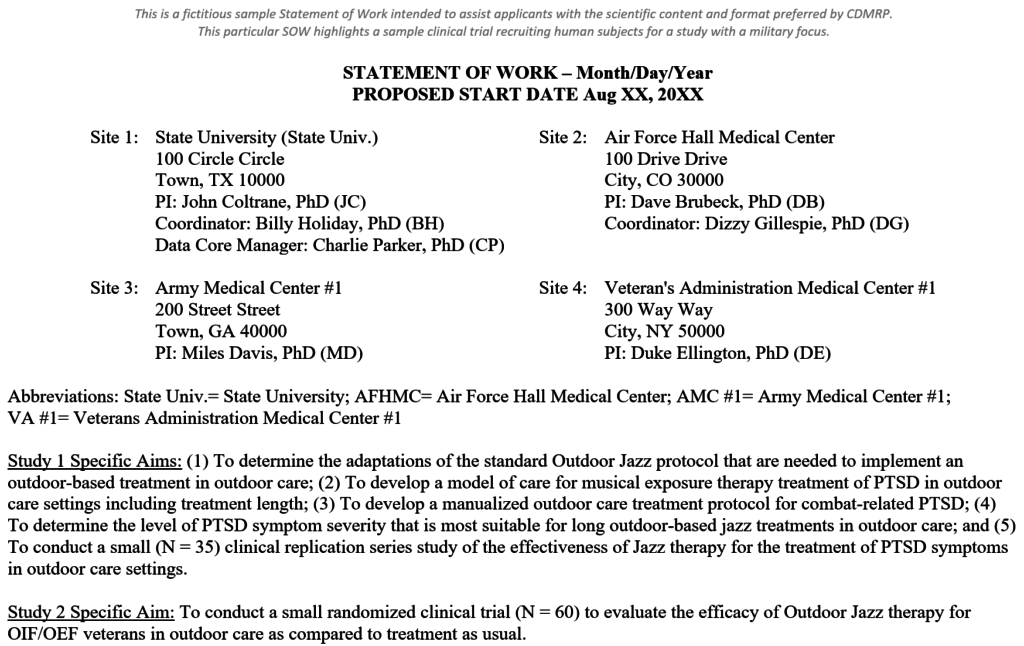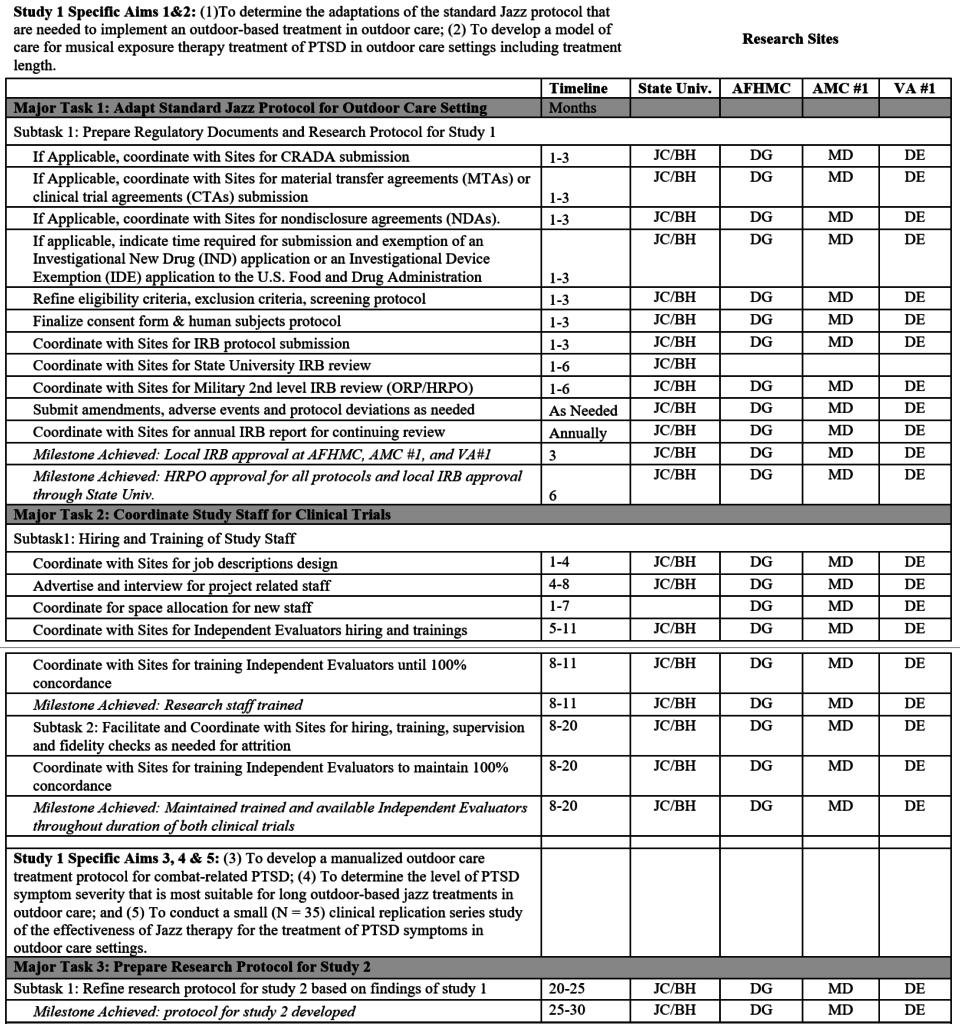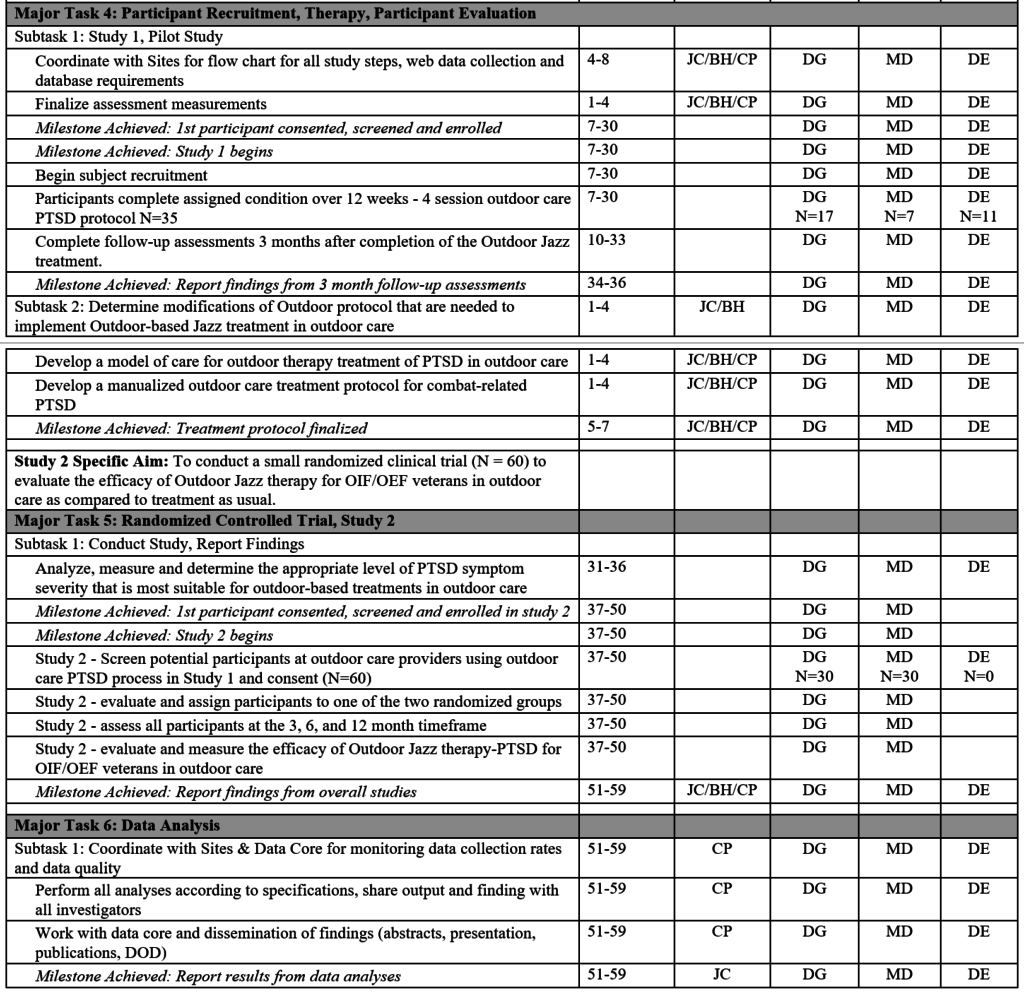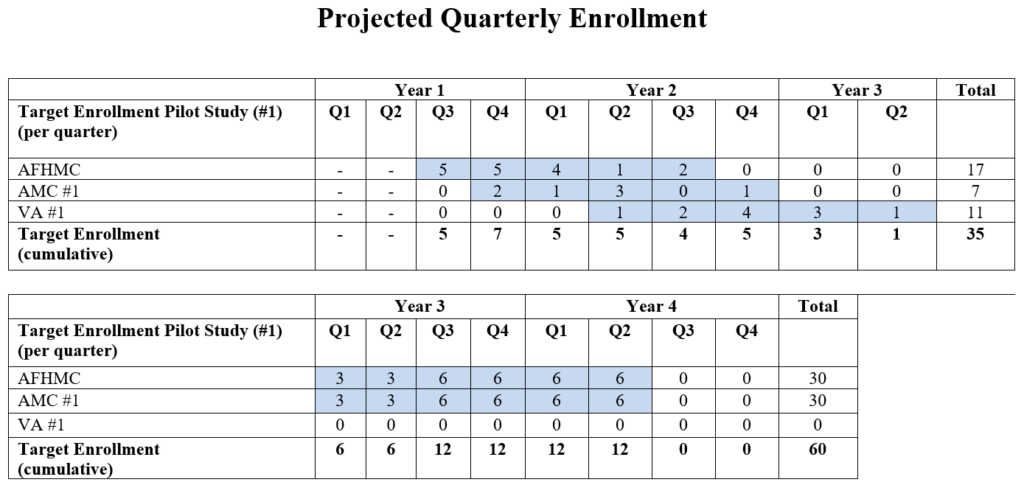
Many Department of Defense (DoD) non-dilutive funding opportunities require applicants to submit a statement of work (SOW) as part of the application process. However, while most applicants will be familiar with the Hypothesis/Specific Aims format of a White Paper or Technical Proposal, many people may not be familiar with the SOW’s purpose or Objectives/Tasks/Milestones/Deliverables-oriented structure. The SOW information presented here is focused on biomedical and human systems technologies rather than “line” or non-medical technologies. However, as biomedical technology grows via connectedness of the Internet of Things (IoT), sensor integration, biomarkers and companion diagnostics, and algorithms to interpret the data, it is also important to be familiar with some terms, such as Work Breakdown Structure (WBS), where a SOW with detailed technical elements and the scope of work is determined for each WBS element.
The SOW is a project management tool that we will discuss at a high level and provide some examples of templates from different DoD Services and some military-assisting Federal Agencies. The SOW lays the groundwork for your project. It not only defines the project scope, deliverables, costs, and timeline, but a SOW can also serve as a legal agreement between client and contractor. The Defense Pricing and Contracting Office (DPC; formerly Defense Pricing/Defense Procurement and Acquisition Policy) that is responsible for all pricing, contracting, and procurement policy matters, including e-Business, in the DoD, defines a SOW as “the portion of a contract which establishes and defines all non-specification requirements for contractor’s efforts either directly or with the use of specific cited documents.”
Statement of Work Format and Content
The SOW format and required content varies between each of the DoD components and their research offices. It is important to follow the application instructions for a given solicitation. However, the following are generally included as part of a SOW:
- Objectives – Major goals or objectives of the proposed research.
- Scope – Include a brief statement of what the SOW should cover and define the scope and limitations of the work to be done.
- Period of Performance – Anticipated duration of the proposed work.
- Place of Performance – Primary sites/locations where the work is to be performed.
- Milestones – Point in time where a recommendation (i.e., milestone decision) is made to the decision authority about starting or continuing an acquisition program into the next Acquisition Phase. Some tips on milestones:
- Milestones should be numbered (1, 2, 3, etc.); do not “roll up” milestones as each milestone must be broken out as a single numbered milestone.
- Do not include too many tasks with one milestone; you can include one or more (a few at most) deliverables for one milestone.
- Deliverables – What your company is delivering to the government to show work progress (e.g., data, designs, reports, software, texts).
- Schedule – Anticipated timeline for major tasks and subtasks.
- Subtask – A task that is part of a more complex task; an act that must be completed as an element of completing a larger and more complex task.
- Task – A clearly defined action or activity (sometimes referred to as a major task) specifically assigned to an individual or organization that must be done as it is imposed by an appropriate authority [JCS-DoD-Dictionary]; descriptive overview of an activity, usually associated with a timeframe (e.g., months 6-12).
SOW Template Example
Below, we provide a SOW template example from the Congressionally Directed Medical Research Programs (CDMRP).
Please note: The SOW examples in this article are for informational purposes only and should NOT be used as official SOW instructions for any DOD or CDMRP solicitation. SOW templates can change, if they are even required as part of the submission process, so it is important to follow the template instructions laid out in solicitation-specific application instructions.
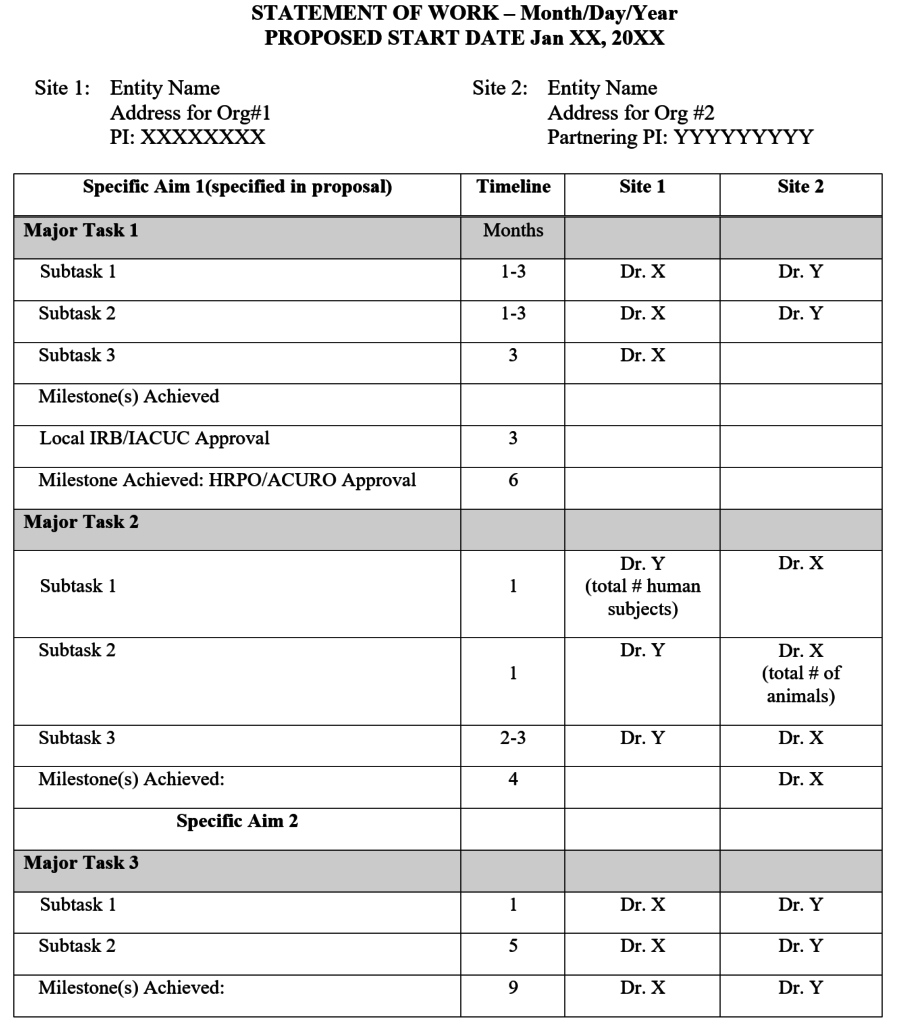
If human subjects are involved in the proposed study, please provide the projected quarterly enrollment in the following table. Note: The Government reserved the right to request a revised SOW format and/or additional information.
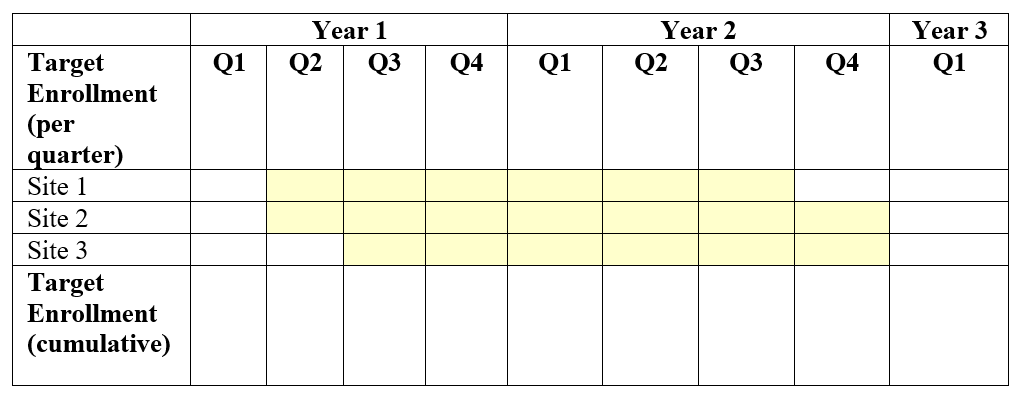
The Electronic Biomedical Research Application Portal (eBRAP) offers additional application forms and templates often used by the CDMRP, as well as by the U.S. Army Medical Research and Materiel Command (USAMRMC), the U.S. Army Medical Research Acquisition Activity (USAMRAA), and the Defense Health Agency (DHA). SOW examples and tips for SOW preparation from these agencies as well as from the Defense Advanced Research Projects Agency (DARPA) are provided in the sections below, as well as on our SOW Resources page.
Milestone Payment and Deliverable Table
The next step is to connect the specific aims, tasks, and milestones of the SOW to your funding payment schedule. A table of milestones (with the same milestone numbers from the SOW), deliverables descriptions, due dates for completion, and the funding required to complete (e.g., total program funds in the table below) will help the Contracting Officer to schedule payment amounts and dates (dependent on the contract type as well). The milestone numbers from the SOW table can have more than one deliverable associated with it. It is important to differentiate the milestone from the deliverables and their descriptions as a measurable milestone can represent multiple factors, such as a deliverable, a demonstration, or other activity or event that marks task completion. It is important to clearly list the deliverables expected from this amount of funding for the reviewers and Contracting Officer to understand. Include quantitative metrics for each milestone whenever possible. Some definitions that are listed below to complete a milestone payment and deliverable table that connects funding to due dates, deliverables and deliverable descriptions, and milestone numbers.
- Due Dates – Actual dates are required; although your company will not know the actual award date, provide estimated dates as close as possible. These can be adjusted at award or after the award.
- Total Program Funds – Each milestone should trigger a payment (as reflected in the Total Program Funds column) for the specified amount by the DoD or Federal Agency. This column is what the Contracting Officer will understand and will work with you on during the contract negotiations. When allocating funds:
- Use only whole dollar amounts (no cents);
- Ensure amounts are reasonable and realistic – these criteria are used for determining impact by reviewers and Contracting Officers; and
- Ensure the amounts reflect the correct level of effort with services.
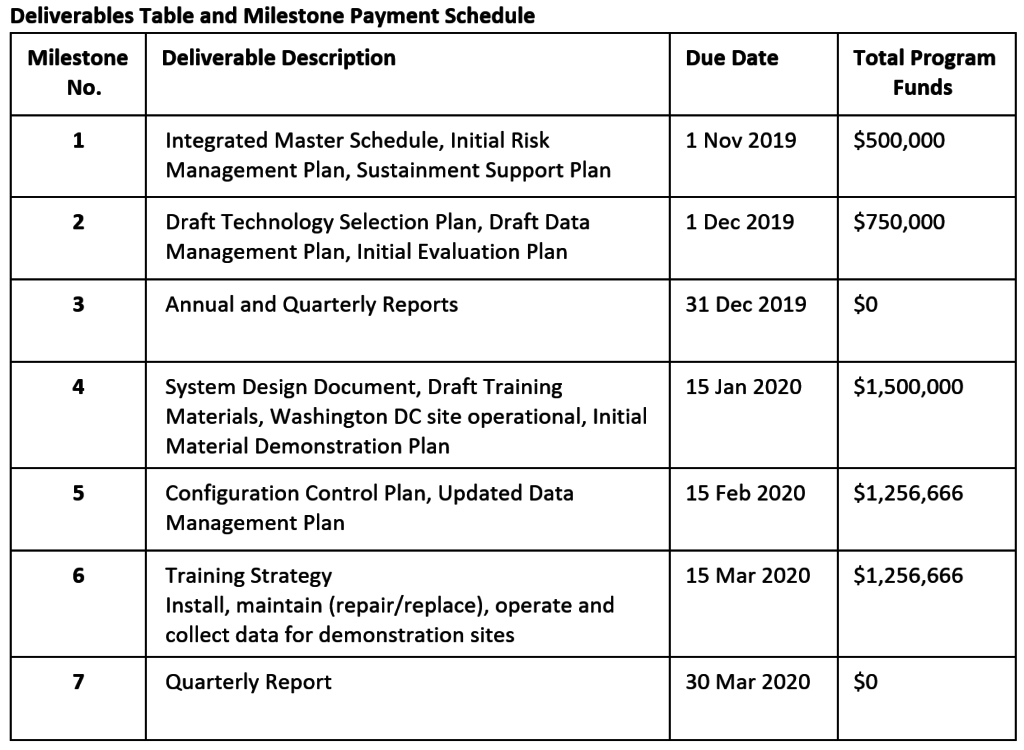
CDMRP SOW Template for Clinical Research
U.S. Army Medical Research and Materiel Command (USAMRMC) SOW Instructions
From the DoD USAMRMC FY18-FY22 Broad Agency Announcement for Extramural Medical Research
Statement of Work (SOW) (two-page limit): Upload as “SOW.pdf.” The SOW outlines and establishes the performance expectations and milestones for which the USAMRMC may provide funding. The SOW will be incorporated into the award document and, as such, is subject to release under the Freedom of Information Act. The SOW should identify all collaborating research sites involved in the performance of the research. Suggested SOW formats and examples specific to different types of research projects are available on the eBRAP “Funding Opportunities & Forms” web page.
A series of relatively short statements should be included that comprise the approach to each of the major goals or objectives of the proposed research. The statements should outline the specific tasks, systems, key assessments/techniques, and materials that are reasonable estimates for testing the proposed hypothesis of the study. A timeline should be included that shows the work statements to be accomplished in each year of the award. Any animal use and/or human subjects recruitment should be included. Allow at least 2 to 3 months for the USAMRMC ORP regulatory review and approval processes for studies involving human subjects and 2 to 3 months for studies involving animal subjects.
U.S. Special Operations Command (USSOCOM) SOW Instructions
From the FY18-FY23 DoD USSOCOM BAA for Extramural Biomedical Research and Development
Statement of Work (SOW) (two-page limit): Upload as “SOW.pdf.” The suggested SOW format and examples specific to different types of research projects are available on the eBRAP “Funding Opportunities & Forms” web page. The SOW outlines and established the PI’s and an organization’s performance expectations for the work to be funded under this award. The SOW in an assistance agreement award established general objectives. The SOW in a contract sets rather specific goals and conditions for each year of the contracted project; the PI and contractor are expected to meet the provisions and milestones of the SOW. The SOW for all award types will be incorporated into the award document and, as such, is subject to release under the Freedom of Information Act.
A series of relatively short statements should be included that comprise the approach to each of the major goals or objectives of the proposed research. The statements should outline the specific tasks, systems, and materials that are reasonable estimates for testing the proposed hypotheses of the study. An outline should be included that shows the work statements to be accomplished in each year of the award. If this proposal/application is part of a larger study, present only tasks that this award would fund. Allow at least 2 to 3 months for the USAMRMC ORP’s regulatory review and approval processes for studies involving human subjects. Allow at least 1 to 2 months for the USSOCOM VRO regulatory review and approval processes for studies involving animals.
Office of Naval Research (ONR) and Naval Research Laboratory (NRL) SOW Template
https://www.onr.navy.mil/work-with-us/how-to-apply/submit-contract-proposal
Statement of Work Template: It is anticipated that the proposed SOW will be incorporated as an attachment to the resultant award instrument. The SOW, without restrictive markings, is your company’s affirmation that the SOW is non-proprietary and releasable in response to Freedom of Information Act (FOIA) requests. At a minimum, the format and content of the Statement of Work should contain the following information. If options are included, separate sections should be included to address what work will occur in the base and each option period.
TITLE OF PROGRAM/SERVICES AND/OR SUPPLIES
1.0 Scope. This section should describe, in general terms, the work effort that will be performed by the contractor.
2.0 Requirements. This section must describe each task(s) the contractor shall perform using complete sentences, active voice, and mandatory terms (“the contractor shall”). The task(s) shall be arranged systematically and logically so that both parties (contractor and government) understand the desired effort. All task(s) must be listed in chronological order. The task(s) must be explained in clear and understandable terms. Include any industry specific standards that need to be adhered to in fulfilling the SOW. (NOTE: Numbering of tasks shall be as follows 1.1, 1.2, 1.3, 2.1, 2.2, 2.3, etc.)
3.0 Deliverables. Deliverable product(s) could consist of, but not limited to, monthly or quarterly progress report (technical and financial), final report, software (executable, source, or operational code), and hardware (contractor acquired property, government furnished property, prototypes). In this section all of the deliverable items should be defined.
Defense Advanced Research Projects Agency (DARPA) Biological Technologies Office (BTO) SOW Instructions
From the DARPA BTO HR001118S0041
Statement of Work (SOW) – The SOW should provide a detailed task breakdown, citing specific tasks and their connection to the interim milestones and program metrics. Each phase of the program should be separately defined. The SOW must not include proprietary information. For each task/subtask, provide:
- A detailed description of the approach to be taken to accomplish each defined task/subtask.
- Identification of the primary organization responsible for task execution (prime contractor, subcontractor(s), consultant(s), by name).
- A measurable milestone, i.e., a deliverable, demonstration, or other event/activity that marks task completion. Include quantitative metrics.
- A definition of all deliverables (e.g., data, reports, software) to be provided to the Government in support of the proposed tasks/subtasks.
Additional SOW Preparation Tips
DARPA recently presented some helpful information on preparing SOWs that is applicable to contracts for most DoD agencies:
- Write a SOW as if it were an attachment to an award.
- Don’t use proposal language (e.g., we propose to do…).
- Break out work between any phases/time periods identified in the BAA.
- Succinctly and clearly define tasks and subtasks.
- Identify the primary organization responsible for task execution.
- Identify measurable milestones and define deliverables.
- Do not include proprietary information!
- If proposing multiple Technical Areas (TAs), do this for each TA.
SOW-Associated Contracting Definitions
The Defense Pricing and Contracting (DPC; formerly Defense Pricing/Defense Procurement and Acquisition Policy) office that is responsible for all pricing, contracting, and procurement policy matters, including e-Business, in the DoD, defines the following contracting terms:
- Statement of Work (SOW) – The portion of a contract which establishes and defines all non-specification requirements for contractor’s efforts either directly or with the use of specific cited documents.
- Performance Work Statement (PWS) – A statement of work for performance-based acquisitions that describes the required results in clear, specific, and objective terms with measurable outcomes.
- Statement of Objectives (SOO) – A government-prepared document incorporated into the solicitation that states the overall performance objectives. It is used in solicitations when the Government intends to provide the maximum flexibility to each offeror to propose an innovative approach. That portion of a contract that establishes a broad description of the government’s required performance objectives.
- Work Breakdown Structure (WBS) – A management tool that identifies and integrates hardware, software, services, data, and facilities and is based on key products and processes in a product-oriented tree structure [DoD IPPD Handbook]. The WBS provides a consistent and visible framework for defense materiel items and contracts within a program. The WBS standard offers uniformity in definition and consistency of approach for developing all levels of the WBS. Generating and applying uniform WBS improves communication in the acquisition process. It also provides direction to industry in extending contract work breakdown structures.
WBS is not frequently included for biomedical tech grants and contracts, but as the biomedical world becomes digitally connected and complex (similar to line or non-medical systems/platforms), this type of framework can also help to manage each element. The levels of the Program WBS must be related to the system requirements and conform to the product-oriented family tree. The detailed technical objectives are defined, and the scope of work is determined for each WBS element. Then, tasks are assigned to each WBS element. Resources, materials, and processes required for attaining the objectives are added incrementally. This relationship allows all items to be traced to the same WBS elements. Thus, the linkage between the requirements specification, the WBS, the SOW, the Integrated Master Plan, and the Integrated Master Schedule provides specific insights into the relationship between cost, schedule, and performance (see DoD WBS MIL STD 881D).
What Now?
If you have helpful anonymized/de-identified examples of SOWs or links to examples of SOWs, please send them and we will add them to our SOW Resources. If you have additional questions, information, or knowledge/experience you would like to share on preparing SOWs for DoD or other Federal agencies, please comment below or connect with us on LinkedIn. If your company has dual-use biomedical or human system technologies that can improve the operational readiness, situational awareness, or healthcare for our military personnel, Veterans, and their beneficiaries, consider utilizing DoD and other military assisting non-dilutive funding resources, such as CDMRP or consortia to accelerate your technologies to DoD, VA, civilian, and international marketplaces contact us to learn how Tier Seven can assist with setting up cooperative R&D agreements with DoD researchers, securing DoD and Federal Agency funding, and providing scientific advisory services.
16 Apr
2019

